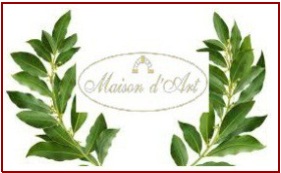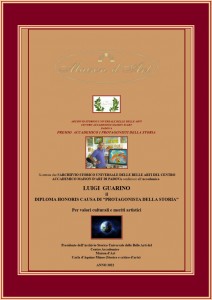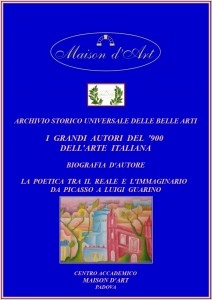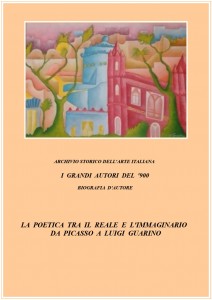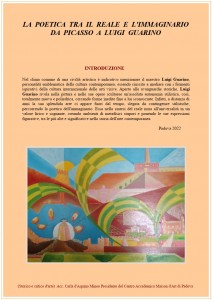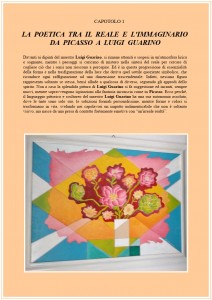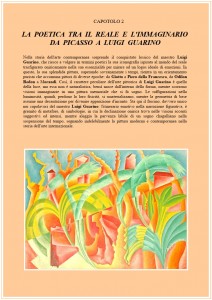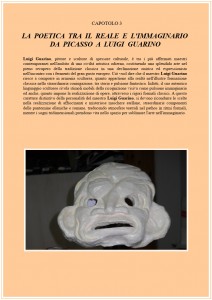Guarino Luigi
Il maestro Luigi Guarino vive ed opera a Santa Maria Capua Vetere (CE)
Cell. 331.6184379
e-mail: raffaeleguarino7
BIOGRAFIA
Guarino è pittore per vocazione eppure ciò non si è rivelato nella sua giovinezza, bisogna aspettare il 1980 per avere un’idea del suo percorso perché cambia modo di dipingere, lui appartiene alla modernità, vorrebbe imitare Cezanne e Picasso, vuole inventare qualcosa, vuole lasciare un segno, alla maniera dei grandi, già, ma come si fa, non c’è una strada ben precisa da percorrere, ma non si scoraggia e incomincia. Dopo dieci anni circa nel 1992, inizia una nuova dinamica di espressione, le sue linee acquistano movimenti non calmi, quasi irrigiditi, le forme appaiono spesse e senza morbidezze, questo modo di rendere le immagini è la conseguenza di uno stile nuovo. È ancora insoddisfacente però la sua rappresentazione, Guarino non disegna più con le matite, addirittura usa il pennarello, i suoi bozzetti sembrano un cantiere aperto, quando finalmente passa alla realizzazione del quadro, colora , pochi tratti ed è già visibile qualcosa, incredibile.
Egli potrebbe seguire, come tanti altri pittori, la via della grazia per raggiungere la bellezza, invece inizia la sua lotta, finalmente dopo il 1995 crea la sua vera identificazione ed acquista il suo stile, è definito dai critici un espressionista astratto, l’ immagine creata non è il gioco dei colori per rappresentare la superficie, ma è il peso e l’equilibrio della composizione, gli elementi hanno una presenza solida e vigorosa. Nel suo sviluppo di creazione, davanti al problema della combinazione forma-figura, sfondo-paesaggio, il suo interesse è risolvere il problema della strutturazione dell’immagine, senza usare lo sfumato o usandolo poco, ma dando forza all’insieme.
Dal 2000 è in piena esplosione, prima era un insegnante interessato a spiegare ai propri allievi la storia dell’arte e le regole del disegno, oggi continua ad insegnare ma esegue, pensa e produce opere artistiche.
Guarino sente ciò che dipinge e quello che esprime lo fa senza timori, sa dove vuole arrivare e ci riesce sempre alla fine. È come se camminasse in una foresta per la prima volta e va dritto senza perdere l’orientamento, la sua non è spavalderia è serenità, tranquillità, lui non teme smarrimenti.
Due sono le forze interne che possiede, la passione e l’ordine. Il suo destino è quello di dipingere e lo fa cercando armonie, l’equilibrio della sua struttura compositiva non viene dalla simmetria, ma da un ritmo crescente di colori e di forme.
Nel 2000 la sua tavolozza ormai tende a schiarirsi, Guarino tende a liberarsi dal suo io per dar più fiducia alla natura.
Non fa mostre personali, dal 2005 lavora assiduamente e partecipa solo a qualche collettiva insieme ad amici pittori e presenta solo un quadro, qualche volta due, sembra non essere interessato a farsi conoscere; finalmente nel 2009 avviene qualche cosa che lo mostra al pubblico, il Comune di Capua lancia l’idea di aprire un museo d’arte contemporanea e, dopo ripetuti incontri, viene invitato a prendere possesso di una sala.
Nel 2010 Guarino mette in evidenza la sua problematica, ma bisogna comprendere bene perché egli ha concluso un suo modo di vedere dopo un’esperienza forte, complessa e piena di dubbi, del disegno e della composizione, lunga 20 anni, non è stato facile, lui è un potente disegnatore nella pittura, in contraddizione totale con la tradizione classica, ma solo apparentemente perché lui cerca la perfezione, la bellezza, l’armonia, la precisione e lo fa a modo suo, quindi lo si può definire anche classico; ma la critica dice che deforma, che è un espressionista astratto, come bisogna definirlo? Sembra un problema.
In conclusione la pittura di Guarino non sopprime il disegno, ma rimpiazza il gesto lineare con il tocco di colore, lui arriva comunque alla conservazione della consistenza degli oggetti, alla materialità dei volumi; durante le interviste dice: “la luce, l’aria ha uno spessore, io sono un meridionale che ama il sole e so che sprigiona raggi sugli oggetti e li fa percepire nello spazio”.
I suoi colori apparentemente non riflettono la luce del sole, ma emettono energie turbinanti che mostrano come Guarino si immerge nella natura.
Ama dialogare con le persone per cui decide di rapportarsi con il pubblico che a sua volta viene coinvolto, insomma avviene un contatto. La domanda è: “ma dov’era il pittore prima?” È possibile che la sua prima personale arrivi a 60 anni? Se verrà fatta a novembre 2010, sarà il suo manifesto, sarà una rivelazione.
Alcuni critici incominciano ad accorgersi del pittore, sottolineandone la sua importanza, oltre ai suoi collezionisti privati si incomincia a notare un interesse per suoi quadri da un pubblico più numeroso, dipinge composizioni e paesaggi, afferma che più in là ritornerà alle nature morte e ai ritratti e sarà una nuova avventura.
Come definire l’artista? Guarino è in grado di abbozzare velocemente un disegno e dipingere subito con i colori, però lui si definisce un pittore lento, incomincia il lavoro con la stessa perizia di un artigiano, di un sarto che ricama, alla fine riesce ad equilibrare la composizione per cui ne esce fuori un lavoro ordinato.
Ogni pittore affronta il problema del tempo, ma lui incurante, alla fine percorre la sua strada con una tranquillità perenne.
La tematica del pittore è semplice, cerca l’ordine quotidiano delle cose, perché nonostante il caos esiste secondo lui.
Lui critica, denuncia ma non rappresenta mai l’immagine della morte, lui parla del vivere, dà ad ognuno una possibilità, ci svela la vanità delle cose e dice con i suoi colori che ha più senso rivolgersi alla risoluzione dei problemi esistenziali.
S.Maria Cv 02-09-2010 Francesca Guarino
BIOGRAPHY
Guarino is a painter by vocation yet this did not reveal itself in his youth, you have to wait for 1980 to get an idea of his career because he changes his way of painting, he belongs to modernity, he would like to imitate Cezanne and Picasso, he wants to invent something, he wants to leave a sign, in the manner of the grown-ups, yes, but how do you do it, there isn’t a precise road to take, but don’t get discouraged and start. After about ten years in 1992, he begins a new dynamic of expression, his lines acquire unsteady, almost stiff movements, the shapes appear thick and without softness, this way of rendering images is the consequence of a new style. However, the representation of him is still unsatisfactory, Guarino no longer draws with pencils, he even uses a felt-tip pen, his sketches look like an open construction site, when he finally goes on to create the painting, he colors, a few strokes and something is already visible, incredible.
He could follow, like many other painters, the path of grace to achieve beauty, instead he begins his struggle, finally after 1995 he creates his true identification and acquires his style, he is defined by critics as an abstract expressionist, the image created is not the play of colors to represent the surface, but the weight and balance of the composition, the elements have a solid and vigorous presence. In his development of creation, faced with the problem of the combination of form-figure, background-landscape, his interest is in solving the problem of structuring the image, without using the nuanced or using it little, but giving strength to the whole.
He has been booming since 2000, before him he was a teacher interested in explaining to his pupils the history of art and the rules of drawing, today he continues to teach but executes, thinks and produces works of art.
Guarino feels what he paints and what he expresses he does it without fear, he knows where he wants to go and always succeeds in the end. It is as if he were walking in a forest for the first time and he goes straight without losing his bearings, his is not bravado it is serenity, tranquillity, he is not afraid of loss.
There are two internal forces that he possesses, passion and order. His destiny is to paint and he does it by looking for harmonies, the balance of his compositional structure does not come from symmetry, but from a growing rhythm of colors and shapes.
In 2000 his palette now tends to lighten, Guarino tends to free himself from his ego to give more confidence to nature.
He doesn’t do personal exhibitions, since 2005 he has been working assiduously and only participates in a few collectives together with painter friends and presents only one painting, sometimes two, he seems not to be interested in making himself known; finally in 2009 something happens that shows him to the public, the Municipality of Capua launches the idea of opening a contemporary art museum and, after repeated meetings, he is invited to take possession of a room.
In 2010 Guarino highlights his problem, but we must understand well why he concluded his way of seeing after a strong, complex and full of doubts experience of drawing and composition, 20 years long, it was not easy, he is a powerful draughtsman in painting, in total contradiction with the classical tradition, but only apparently because he seeks perfection, beauty, harmony, precision and he does it in his own way, so he can also be defined as classic; but critics say that he deforms, that he is an abstract expressionist, how should he be defined? Seems like a problem.
In conclusion, Guarino’s painting does not suppress the drawing, but replaces the linear gesture with a touch of colour, he still manages to preserve the consistency of the objects, the materiality of the volumes; during interviews he says: “light, air has a thickness, I am a southerner who loves the sun and I know that it releases rays on objects and makes them perceived in space”.
His colors apparently do not reflect sunlight, but emit swirling energies that show how Guarino immerses himself in nature.
He loves to dialogue with people so he decides to relate to the public which in turn becomes involved, in short, a contact takes place. The question is: “but where was the painter before?” Is it possible that his first personal exhibition will arrive at the age of 60? If it takes place in November 2010, it will be his manifesto, it will be a revelation.
Some critics begin to notice the painter, emphasizing his importance, in addition to his private collectors, he begins to notice an interest in his paintings from a larger audience, he paints compositions and landscapes, he says that later he will return to still lifes and portraits and it will be a new adventure.
How to define the artist? Guarino is able to quickly sketch a drawing and immediately paint with colours, but he defines himself as a slow painter, he begins his work with the same skill of a craftsman, of a tailor who embroiders, in the end he manages to balance the composition so an orderly work comes out of it.
Every painter faces the problem of time, but he careless, in the end he goes his way with a perennial tranquility.
The painter’s theme is simple, he seeks the daily order of things, because according to him chaos exists.
He criticizes, denounces but never represents the image of death, he talks about living, gives everyone a chance, reveals the vanity of things and says with his colors that it makes more sense to turn to the resolution of existential problems.
Francesca Guarino
BIOGRAFIA D’AUTORE a cura dello storico e critico d’arte Carla d’Aquino Mineo
STORIA DI ARTE VISSUTA DEI GRANDI AUTORI DEL ‘900
LA POETICA TRA IL REALE E L’IMMAGINARIO DA PICASSO A LUIGI GUARINO












